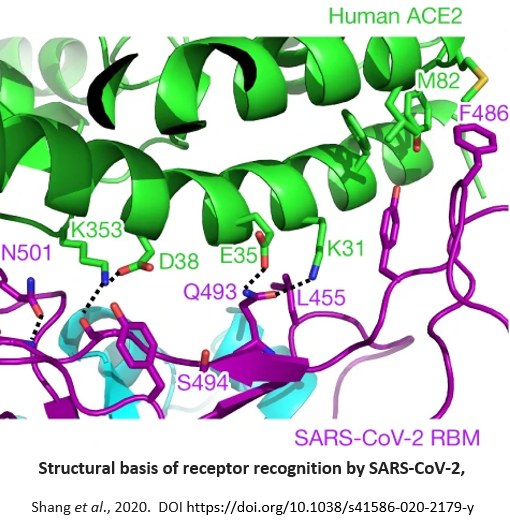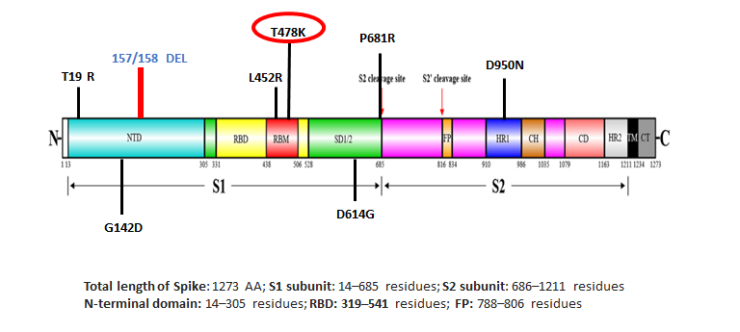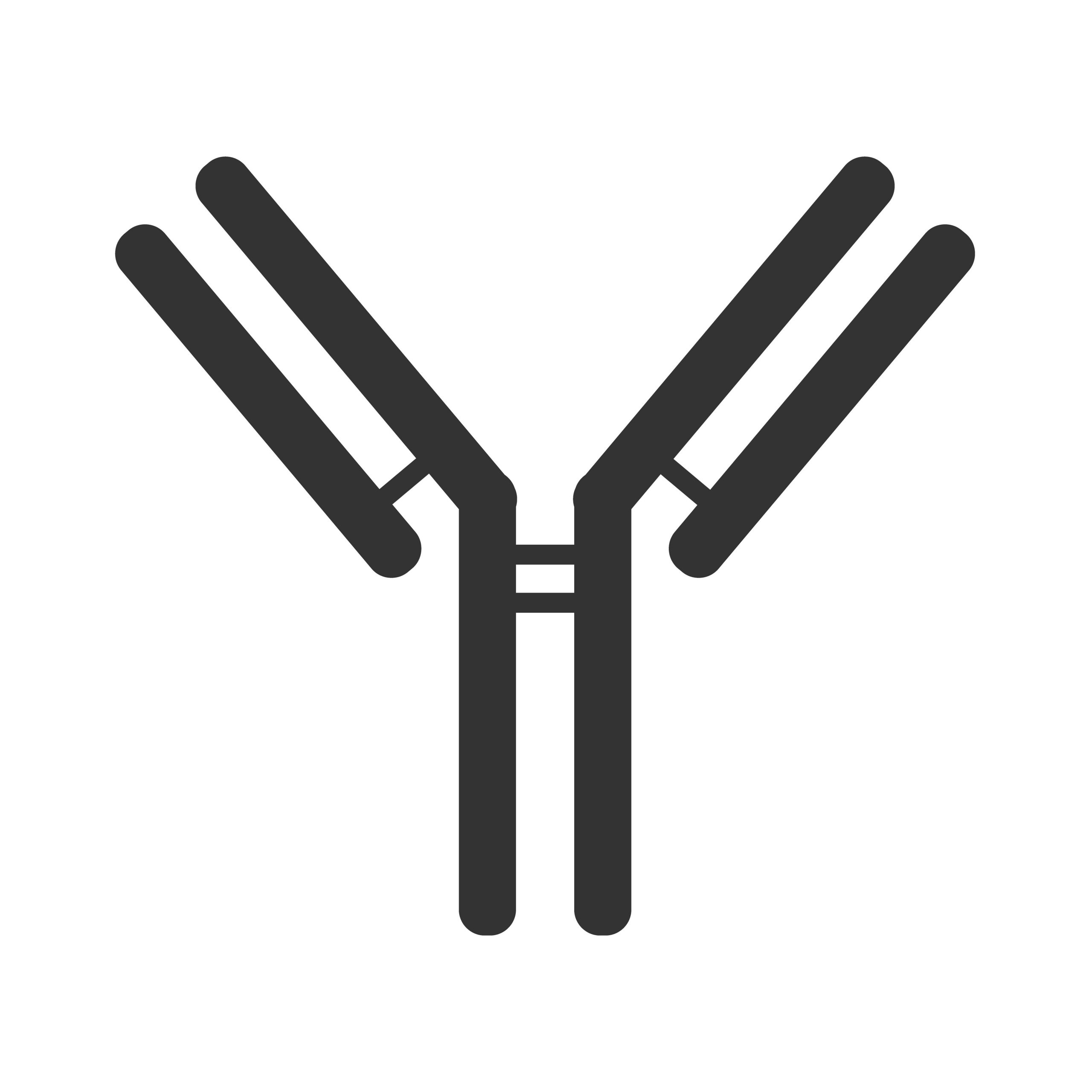The Role Of The RBM:ACE2 Interface.
A little over a year ago, we set out how increased infectiousness meant greater vulnerability, i.e. a new variant may be more infectious but it is also more susceptible to destruction by the innate immune response. The chances are that most people now know what a structural spike protein is but few will understand why it is relevant. One of SARS-CoV-2’s four structural proteins, the spike protein contains the receptor binding domain (RBD) and S1 & S2 subunits. This domain contains the virion’s primary ‘offensive weapon’ as well as some of its related defensive countermeasures. The RBD contains the receptor binding motif (RBM) which contains the ACE2 binding ridge loops. The RBM:ACE2 interface is what allows a virion to bind to a host cell, which begins the viral replication cycle.
How well a virion can bind to a receptor on the target cell determines binding affinity and binding affinity determines infectiousness. Changes to the composition of the RBM:ACE2 interface change its binding affinity, making it more or less effective at binding, therefore, more or less infectious.
SARS-CoV-2’s RBM:ACE2 interface contains four residue motifs in the loops of the binding ridge, compared to SARS-CoV that contain three [Shang et al., 2020]. This additional residue along with the conformation of these four residues allow the loop to be more flexible, enabled by a hydrogen bond between Ala475 and Asn487 [Shang et al., 2020], which brings the RBM into closer contact with the ACE2 receptor. This is essential as SARS-CoV-2’s natural electrostatic properties are weak, meaning that it has to be brought closer to the ACE2 receptor to facilitate binding affinity.
Binding Affinity Increases Infectiousness.
Improving the RBM:ACE2 interface has two effects; firstly, it increases binding affinity, as evidenced by a strong salt bridge at residue Arg439 [Pylaeva et al., 2018] and additional hydrogen bonds at Arg408, Ala475 and Phe486. Secondly, it exposes more of the RBM binding ridge to the N-terminal helix of the ACE2 receptor. At this point, it is noteworthy to highlight the position of these residues in SARS-CoV-2’s genetic sequence – all around the RBM – as well as the presence of arginine at residue 439.

The source RBM:ACE2 interface looks like this: SNNLDSKVGGN YNYLYRLFRK SNLKPFERDI STEIYQAGST PCNGVEGFNC YFPLQSYGFQ PTNGVGYQ, which is its sequence of amino acid residues. As we set out last month, a change in a single nucleobase within a nucleotide can cause a codon change and therefore amino acid substitution. This will change a negative to a positive – or vice versa – or increase or decrease the strength of salt bridge or hydrogen bond. Biochemically, arginine and lysine have the best properties for increased bonding, which is why they have been present in substitutions within the RBD around the RBM of all the dominant, global variants.
D614G was an adenine to guanine single nucleotide polymorphism at position 23,403 that triggered an aspartic acid to glycine amino acid substitution at residue 614 in the RBD, which reduced S1 subunit shedding and changed the conformation of the protomer from majority ‘3-down’ to ‘1-up‘. Yurkovetskiy 𝘦𝘵 𝘢𝘭. [2020] showed this led to a 9-fold increase in infectiousness but crucially no increase in infectivity [Walls 𝘦𝘵 𝘢𝘭., 2020; Weissman 𝘦𝘵 𝘢𝘭., 2020]. Think of the virion’s receptor binding ridge loop and the cellular membrane’s ACE2 receptor as the two sides of a piece of Velcro, where ‘1-up’ means the virion holding out its side more often, so it has a better chance to stick.
Technically at that point – between March & June 2020 – SARS-CoV-2 actually gave up as the move to 1-up conformation meant increased presentation of the exposed epitope, making it more visible and therefore vulnerable to neutralising antibodies [Mansbach 𝘦𝘵 𝘢𝘭., 2020; Weissman 𝘦𝘵 𝘢𝘭., 2020; Yurkovetskiy 𝘦𝘵 𝘢𝘭., 2020].
D614G was 2020’s global, dominant variant and was then superseded in 2021 by a threonine to lysine substitution at residue 478 – T478K – that became the lead substitution in Delta, which we evaluated in July 2021 Why Delta / B1.617.2 Is NOT A Problem.

Arginine And Lysine Lead The Way.
Using the above analogy, arginine or lysine makes the sticky side of the Velcro stickier. This gave Delta greater binding affinity and therefore increased infectiousness but no increase in infectivity. At the same time, E484K, a glutamic acid to lysine substitution at residue 484, later designated Gamma, showed increased infectiousness but no increase in infectivity.
In late 2021 the next dominant, global variant emerged, Omicron, this time with two lead substitutions, one – N440K – being to lysine and the other – Q493R – being to arginine. These main, global variants have occurred annually, unsurprising since coronaviruses are seasonal irritants, although the key difference with Omicron is that it shows increased infectiousness but with a significant decrease in infectivity.
You can now see the relevance of the substitutions 408; 439; 440; 475; 478; 484; 486; 487; 493 in that firstly, all are around the RBM and in very close proximity to each other, some even adjacent. Secondly, the majority contain substitutions to arginine or lysine that improve binding affinity through enhanced biochemical attraction. It took us less than one minute to evaluate Omicron; isolate the relevant substitutions; identify their composition and deduce that Omicron would be more infectious but without any increase in infectivity.
When you hear politicians and healthcare leaders talking about the ‘spread of Delta’ or ‘Omicron could be the most infectious yet’ they are ignoring how a virus evolves phylogenetically. It is unrelated to geography, something we first analysed in March 2021 Why Geographical Naming Of Variants Is Wrong. Each dominant, global variant has contained one or more substitutions around the RBM that have enhanced the effectiveness of the RBM:ACE2 interface. These are deliberate amino acid substitutions and what coronaviruses do [Mercatelli and Giorgi, 2020] and have been doing since they first became pathogenic, both in the alpha genus [Chibo and Birch, 2006; Ren 𝘦𝘵 𝘢𝘭., 2015; Vijgen 𝘦𝘵 𝘢𝘭., 2005] and beta genus [Guan 𝘦𝘵 𝘢𝘭., 2003; Song 𝘦𝘵 𝘢𝘭., 2005].
Each Wave Is Less Dangerous Than The One Before.
At the same time as SARS-CoV-2 has been evolving in a continuous attempt to ensure its own survival through natural selection, the antiviral C-to-U editing occurring on an intracellular basis as part of the innate immune response has been disrupting and degrading its replication cycle. Subtly so as to escape detection by SARS-CoV-2’s nsp14-ExoN, the immune system has been picking apart SARS-CoV-2’s genetic sequence, changing the odd letter here and there.
We actually highlighted as early as September 2020 – 16 months ago now – that SARS-CoV-2 would revert through phylogenetic evolution toward its common cold-causing beta genus 𝘤𝘰𝘳𝘰𝘯𝘢𝘷𝘪𝘳𝘪𝘥𝘢𝘦 relatives HCoV-HKU1 and HCoV-OC43. This process is now almost complete. It is a process that would have happened regardless of government response and has been completely unaffected by the plethora of pointless restrictions and measures imposed to keep you safe.
Unless You Follow Government Advice.
Ineffective rules dreamt up by fantasists and those who believe that sciency fiction is science fact and that speculative predictions are actual outcomes. This was apparently the first virus in history that could count how many people are in the shop at the same time; tell the time; read; follow one-way signs; pass over key workers in favour of only targeting non-key workers who dare venture outside; ignore family members in the same room for months on end but kill friends and strangers on sight and ignore groups of 6 but kill all those present as soon as a seventh turns up.
So after almost two years of being told whar to do by people who have no idea what they are talking about, what is the net result? How safe have the government and NHS kept the UK population?
The UK’s COVID-19 mortality rate is still over 3.1-times higher than the worldwide average (@0500UTC 11/02/22, source: Johns Hopkins Coronavirus Resource Center/Worldmeters). So not only were all the rules & restrictions pointless as well as a waste of more than £420 billion of taxpayers’ money but they made the situation worse. Far, far worse. The 3.1-times higher mortality rate caused by the government and NHS response equates to 108,204 excess deaths.
108,204 individuals whose deaths were entirely avoidable and completely unnecessary.
108,204 people sent to their deaths by the incompetence, lies, arrogance and insouciance of Chris Witty (may his name be blotted out), Patrick Vallance (may his name be blotted out), Matt Hancock (may his name be blotted out), Nadhim Zahawi (may his name be blotted out), Sajid Javid (may his name be blotted out) and Boris Johnson (may his name be blotted out).
Every one of those lives lost was someone’s beloved, spouse, parent, child or sibling. Every one of them deserved at least a fighting chance but they were denied that and instead forced to follow government guidance that cost them their lives.

Follow common sense. Never ever follow UK government advice.